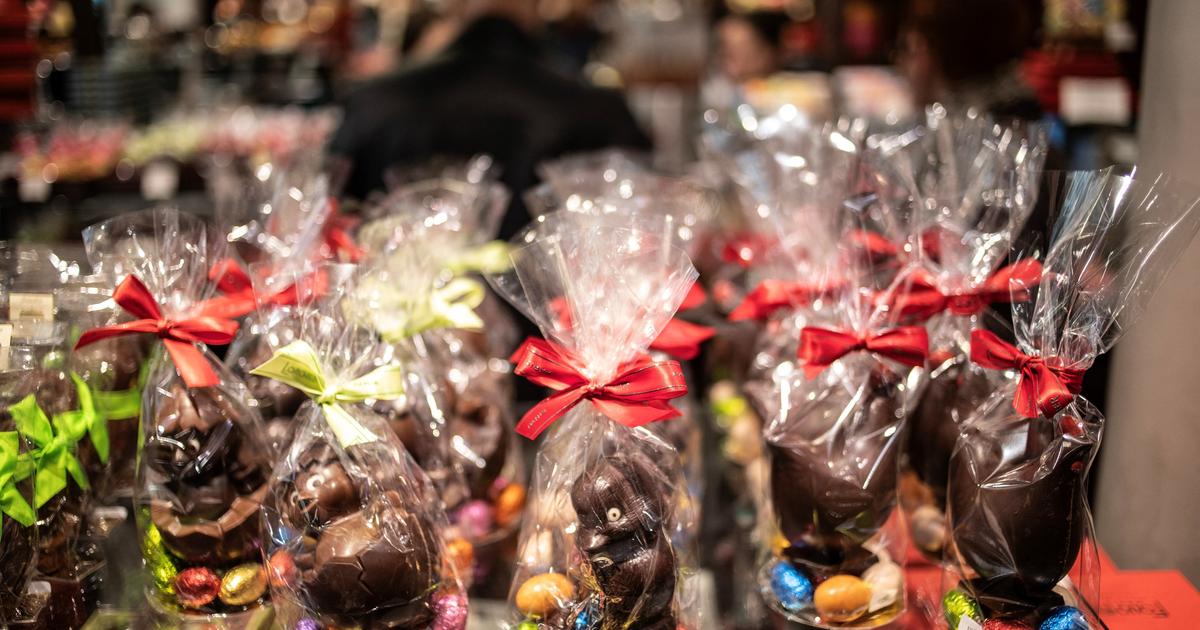Bad news ahead, celebrating Easter will cost more this year.
The cause, in particular, is the surge in the price of cocoa, an essential raw material, which has occurred in recent months.
In February, the ton of cocoa beans sold for around 6,000 dollars (around 5,500 euros), an increase of 150% compared to January 2023. In March, the machine got carried away, the price of the ton having reached the milestone of 10,000 dollars (around 9,200 euros) in New York this Tuesday before falling slightly.
This outbreak has immediate repercussions on in-store labels.
And this, while 98.5% of households consume chocolate, at an average of 7.3 kilos per year per French person, according to figures from the Chocolate Union.
To understand this surge, we must turn to the African continent.
Ivory Coast and Ghana are by far the world's two main producers of cocoa beans, representing 60% of total production last year according to the International Cocoa Organization.
But in recent months, these two West African countries have experienced poor harvests due to heavy rains and a pod disease, followed by a bout of drought.
As a result, cocoa production fell by 8%.
Also read: “Chocolate and ice cream, which I loved before, disgust me today”: how anti-obesity drugs are disrupting health and the economy
Heatwave in Africa
Since cocoa trees only grow in equatorial zones where the temperature is around 20°C, the growing areas are restricted and concentrated in West Africa.
However, climate change is now greatly affecting this region of the world.
Since February, these countries have been going through a long episode of drought, with temperatures reaching 40°C, unprecedented for this time of year.
Added to this intense drought was the El Niño factor, a recurring natural climatic fluctuation in tropical areas.
If this phenomenon already represents an obstacle for many farmers, its exacerbation by climate change has not helped matters, notes John Plassard, analyst at Mirabaud:
“It has damaged crops and favored the spread of black pod disease. .”
But this extreme heat is not the only one responsible for the rise in cocoa prices.
Indeed, an intense rainy season briefly replaced the drought in December 2023 in certain West African countries.
The record rainfall brought about a fungal infection, which caused the cocoa beans on the trees to rot.
Called “swollen shoot”, or cocoa shoot edema virus, this disease reduces production.
Finally, the rising costs of pesticides and fertilizers have imposed financial constraints on African farmers.
From then on, the entire supply chain was put to the test.
5% inflation
The setbacks affecting the cocoa bean are not the only ones responsible for this general increase in the price of chocolate.
Indeed, inflation affects other ingredients in rabbits and other tablets, such as milk or sugar.
The latter
“saw its price double between 2020 and 2023 on the stock markets, to a level which had not been reached for 20 years”,
although it
“has been falling since last December”,
notes the UFC-Que Choisir .
This is also due to difficult weather conditions in Brazil and India, the world's two leading producers.
Added to this are packaging, transport and salaries, which are all fixed costs which ultimately raise prices for the consumer.
As a result, chocolate makers, for whom Easter represents nearly 10% of annual sales, must pass on the increase in their production costs if they want to avoid cutting into their margins.
The famous Swiss brand Lindt & Sprüngli, which has already inflated its prices by 10% in 2023, for example announced at the beginning of March that it intended to increase them by 5% on average this year.
On the shelves, the prices of Easter bestsellers have increased more than the average food item.
UFC-Que Choisir noted overall inflation of 5% compared to Easter 2023, well above food inflation in March, which fell to 3%.
When compared per kilo, some prices are dizzying.
The Maxi Kinder Surprise is, for example, sold for 60 euros per kilo in supermarkets.
Inflation does not spare Easter chocolates.
UFC-What to choose
23 euros budget per household
The Easter weekend nevertheless remains a safe bet for chocolatiers.
According to the Chocolate Union, the French have
“an average budget of 22.60 euros per household”.
And the attraction for Easter continues.
Last year, sales during this holiday were higher than those recorded in 2022,
“up 4.6% in volume”
.
More generally,
“the chocolate market remained stable”
last year, notes the union.
With nearly 3.6 billion euros in turnover, the sector continues to generate revenue for large and medium-sized retailers as well as manufacturers.
Tablets and spreads are also the most promising products.
Professionals strive to keep prices accessible to as many people as possible, says Gilles Rouvière, general secretary of the Chocolate Union.
Overall, the prices of chocolates in supermarkets increased in 2023 by 11.3% across the entire category,
“below the annual inflation of consumer products which is 12.8% over the same period”
.
Despite this, given the context, many consumers do not hesitate to turn to lower-end chocolate products or buy in smaller quantities.
Manufacturers could be tempted by “shrinkflation
”
– meaning the reduction in the size of chocolate products – notes Ole Hansen, head of raw materials at Saxo Bank.
If
“the explosion in cocoa prices is a reality, the increase in the prices of Easter chocolates is under control,”
notes Gilles Rouvière.
In fact, the recent evolution of the price of cocoa and the peaks it has reached will rather impact sales for Christmas 2024 and Easter 2025, since distributors obtain supplies several months in advance.
“This time, we anticipated the Easter chocolate campaign, which made it possible to limit the increases, which are less than 10%,”
declared this Wednesday morning the CEO of Système U, Dominique Schelcher, on BFMTV/RMC .

